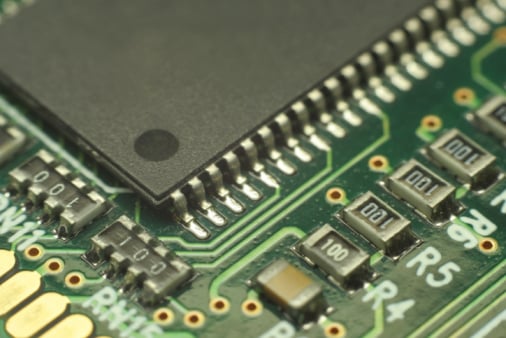Semiconductor Makers Going Mobile in 2013
January 7, 2013 by Paul Ausick
How bad was it? About a year ago, Intel Corp. (NASDAQ: INTC) projected that sales of the company’s heavily promoted Ultrabook computers would account for 40% of all notebook shipments in 2012. Taiwan’s Digitimes, however, estimates that Ultrabook sales managed to gain only a 10% share of notebook shipments. Like the Chicago Cubs: “Wait ‘til next year.”
At the beginning of 2013, we want to take a look at what is going on in the chip business and what we might expect. According to IDC, the computer industry will have shipped about 1.19 billion devices in 2012, comprising desktop PCs, portable PCs, smartphones and tablets. Of those shipments, 149.2 million will be desktop PCs, 205.1 million are portables, 717.5 million are smartphones and 122.3 million are tablets.
The trajectories, though, say a lot about where the growth is. IDC did not offer a forecast for 2013 shipments, but the company did say that desktop PC shipments are expected to grow by just 1.2% through 2016, portable PC shipments are expected to grow by 31.1%, smartphone shipments are expected to grow by 95.9%, and tablet shipments are figured to rise by 131.2% by 2016. The moral of the story is that unless a chipmaker is in the smartphone or tablet business, the next few years are going to be pretty slow.
The semiconductor makers are in many ways captive to the macroeconomic forces that we all have to deal with. The European debt crisis, slowing growth in emerging markets and regional conflicts all will have an impact on chip sales in 2013. An analyst at IHS iSuppli noted:
The global economy continues to be the most critical variable affecting the semiconductor space both this year and the next, especially because the chip industry is highly dependent on consumer spending. Until consumers believe their financial position is stable or improving, consumer spending will likely remain soft.
Intel and Advanced Micro Devices Inc. (NYSE: AMD) are squarely on the low-growth side of the chip sales equation. But AMD is far worse off than Intel. The distant number two PC CPU maker has essentially no presence in the mobile market and only a barely perceptible position in the desktop and portable markets. The company is not profitable, and the share price fell nearly 60% in 2012.
Last week Intel said it would soon launch a cloud-based web TV service and a set-top box using the firm’s own chips. That’s fine, but Intel said early last year that the service would be out by the end of 2012. Making the hardware is simple compared with getting agreements from movie and TV content producers. Intel’s shares were down about 20% in 2012.
Intel faces margin pressure and increasing competition from ARM Holdings PLC (NASDAQ: ARMH), which has begun to design low-power, high-performance chips for both the PC and the server markets. Unless Intel can gain a foothold in the tablet and smartphone markets, the problems at the world’s largest chipmaker will not end next year either.
As for ARM, shares have risen 32% in the past 12 months, more than double the share price increases for either Qualcomm Corp. (NASDAQ: QCOM) or Broadcom Corp. (NASDAQ: BRCM). Qualcomm shares took a beating last month when Apple Inc. (NASDAQ: AAPL) reportedly cut orders from suppliers, including Qualcomm, which supplies Apple with baseband chips for its mobile devices. Qualcomm also supplies chips for Google Inc. (NASDAQ: GOOG), Samsung Electronics, LG Electronics and Nokia Corp. (NYSE: NOK), which also use different Qualcomm processors. For every Apple device with a single chip that Qualcomm loses, it likely gains an Android-based device that uses at least two Qualcomm chips.
Besides Intel, which could push hard into Qualcomm’s market share, Nvidia Corp. (NASDAQ: NVDA) could be a threat. Nvidia’s shares are down about 11% over the past 12 months, primarily because its graphics chips are so heavily used in desktop and portable PCs. The company also is having reasonable success breaking into the mobile market.
Another casualty of the decline in desktop and portable shipments is Marvell Technology Group Ltd. (NASDAQ: MRVL), where shares are down about 50% in the past 12 months. The company makes hard-drive controller chips, and the fewer PC shipments, the lower demand for hard drives.
One last company to look over is Micron Technology Inc. (NASDAQ: MU). If the company can complete its acquisition of Japan’s bankrupt Elpida Memory, Micron will become a serious player in the flash memory business, where SanDisk Corp. (NASDAQ: SNDK) struggled last year.
Finally, the Market Vectors Semiconductor ETF (NYSEMKT: SMH) is down nearly 4% over the past 12 months, but it has recently ticked up from a yearly bottom in mid-November. Intel is the fund’s largest holding, followed by Taiwan Semiconductor Manufacturing Co. Ltd. (NYSE: TSM), which together comprise more than a third of the fund’s holdings. The fund’s exposure to the mobile market is concentrated in ARM and Broadcom, which together total about 10.5% of holdings.
As far as growth is concerned, the writing is on the wall and the word is “mobile.” This year shapes up as another year of improvement in shipments of mobile devices with more years of growth to follow.
Sponsored: Find a Qualified Financial Advisor
Finding a qualified financial advisor doesn’t have to be hard. SmartAsset’s free tool matches you with up to 3 fiduciary financial advisors in your area in 5 minutes. Each advisor has been vetted by SmartAsset and is held to a fiduciary standard to act in your best interests. If you’re ready to be matched with local advisors that can help you achieve your financial goals, get started now.